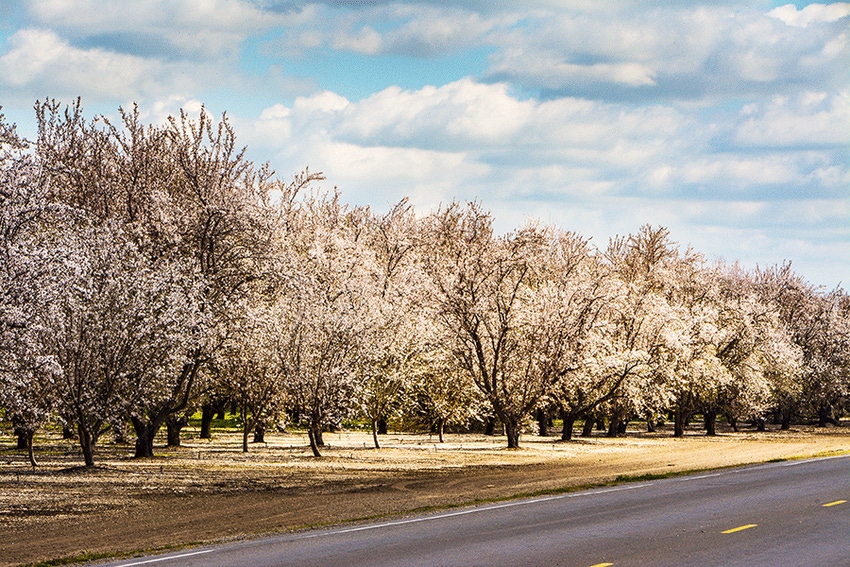
With the arrival of May the growing season heats up in West Coast nut orchards and a proper balance of soil nutrients and the need for fertilization becomes paramount in the health and well-being of tree and nut development.
Some have already addressed soil nutrient profiles and if they haven’t already, are preparing for their first application of nitrogen (N). While N is but one of the chemical elements required for good soil and plant health, it is the most vital and the most common used in agriculture.
While nitrogen is not only required and beneficial for farming operations, it also comes with a down side – nitrate pollution.
California law requires the responsible use of N to prevent groundwater pollution. In the Central Valley region, a regulatory program administered by the Central Valley Regional Water Quality Control Board requires nut crop growers to use best N management practices to reduce nitrate loading and the leaching of nitrogen into groundwater.
“Historically in California agriculture, we have not really had the tools necessary to control the amount of nitrogen we use in our orchards. In the absence of those tools, growers have erred on the side of applying enough nitrogen to satisfy the need of every tree in the orchard, the consequence of which we end up providing more than needed for the majority of the orchard, resulting in excess amounts of nitrogen and often compromising the quality of groundwater,” said Patrick Brown, a professor in the University of California (UC)-Davis’ Department of Plant Sciences.
Brown specializes in the physiology and biochemistry of plant nutrient intake and efficiency. He is one of a team of scientists who developed the University of California Agriculture and Natural Resources’ (UC-ANR) most recent guide to Nitrogen Management in Nut Crops.
“It’s a constitutional right that every person in California shall have access to good, clean drinking water, [but] we are finding ourselves in conflict between providing adequate amounts of good quality water for the rural population while managing maximum productivity for agriculture,” he said.
According to the UC nitrogen management guide, N is the nutrient plants require in the largest quantity for better yield and quality. It is also an integral constituent of proteins, nucleic acids, chlorophyll, co-enzymes, phytohormones, and secondary metabolites, and its deficiency can negatively affect yield.
Nitrogen-deficient plants are stunted, with narrow, small, pale leaves. Excessive N applications increase vegetative growth and susceptibility to diseases that infect fruit, kill spurs, and reduce yields in subsequent years.
But proper management of nitrogen to avoid nitrate pollution is not only a sound agricultural principle, it is mandated by regulation.
Brown notes that during years of excessive rain in the spring and summer seasons like many West Coast orchards received this year, leaching of available nitrogen becomes more problematic. The movement of excessive water through the soil causes a lot of residual nitrogen to move into the ground water basin. Not only do heavy rains leach more nitrogen, it also dilutes available nitrogen.
Heavy rains also make irrigation timing more critical, as flooding fields with irrigation water further complicates leaching problems.
“The goal of a good irrigation and fertilization program is to provide the nutrients without pushing the nitrogen through the soil profile. You can minimize the potential for that by spreading your application program into as many smaller applications as possible throughout the growing season and by ensuring you have good uniformity of irrigation across the property,” he said.
He adds, it is best to make certain to apply fertilizer near the end of the irrigation cycle, so it is the last thing applied and with only a minimum amount of water.
Concerning Nutrient Management
Brown says one of the most important considerations for nitrogen applications is knowing your yield expectation.
“That’s the very first thing you should consider when determining what your nitrogen application rate will be. Another consideration is keeping the applied nitrogen within the root zone.”
As important, Brown says the right timing for applications are critical.
According to Brown and the UC-ANR Nitrogen Management guide, the application of N is best when applied in stages across the critical months of plant and nut growth, generally between March (in southern regions) through August. By dividing applications in multiple stages helps to prevent leaching and nitrate pollution.
“It is also important to remember you can’t adequately and efficiently use nitrogen if you have not managed other nutrients in the orchard,” he warned.
By using soil sensors and keeping soil profiles up-to-date, a proper balance of chemical elements in the soil will further maintain healthy nutrient levels and reduce the chance of leaching and groundwater pollution.
For a more complete look and a comprehensive step-by-step guide to nitrogen management in tree nut orchards, connect to the new UC-ANR guide.
For more news on tree nuts as reported by growers and farm advisors, subscribe to the Tree Nut Farm Press e-newsletter.
About the Author(s)
You May Also Like






